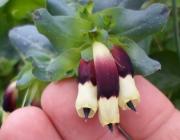Kheloufi A, Mansouri LM.
Effect of sulphuric acid on the germination of a forage tree Acacia nilotica (L.) subsp tomentosa. Livestock Research for Rural Development [Internet]. 2017;29 (2) :1-11.
Publisher's VersionAbstract
Acacia nilotica is a ligneous forage tree of the family of Fabaceae (Legumes). This tree has a great agro-forester, sylvo-pastoral and nutritional importance in the arid and semi-arid regions where the plants cover is in a permanent reduction. The first cause is the lack of reforestation project. In addition, the stage of germination for the legume trees meets the problem of the integumentary dormancy (vernalization) and the global warming which limits the germination and the establishment of an important plant population. The germination rate in the nature is only between 5 and 10% according to the forest departments. The effect of a chemical pretreatment to improve the germination was studied by analyzing 3 parameters (germination kinetics; MGT: germination mean time (days) and GRI: germination rate index) after 4 times of incubation (4, 8, 12 and 16 days) in Petri dishes.
The pretreatment consisted of immersion of the seeds in concentrated sulphuric acid (98%) for 7 durations: 0 (Control), 20, 40, 60, 80, 100 and 120 minutes. For all the A. nilotica seeds treated in this study, the increasing duration of the soaking in the sulphuric acid improved significantly (p < 0,001) the germination by reducing the MGT and by increasing the GRI. The best germination reached a rate of 95%, with a reduced MGT (1 day) and a high GRI (47,33±2,64) for 100 minutes of soaking in the sulphuric acid. However, the immersion during 120 min reduced the GRI to (26,5±1,9). Such a pretreatment of 100 min is thus recommended to increase the rate of germination of the acacia trees implanted by the forest services in Algeria.
Kheloufi A.
Germination of seeds from two leguminous trees (Acacia karroo and Gleditsia triacanthos) following different pre-treatments. Seed Science & Technology [Internet]. 2017;45 (1) :1-4.
Publisher's VersionAbstract
A lot of forest species are abandoned because of difficulty with seed germination and establishment. A study was carried out to investigate the effects of wet scarification on seed germination of Acacia karroo and Gleditsia triacanthos, by considering germination percentage (GP), mean germination time (MGT) and germination rate index (GRI). Pre-sowing treatments included immersion in concentrated sulphuric acid for 30, 60 and 90 minutes, and immersion in hot water (100°C) for 5, 10 and 15 minutes. Soaking in distilled water (control) did not stimulate germination in either of the species. Treatments significantly (P < 0.001) affected GP, MGT and GRI in both species. Increasing the duration of soaking in sulphuric acid (from 30 to 90 minutes) improved the germination for G. triacanthos to 96%. High germination (99%) was attained for A. karroo seeds after soaking in sulphuric acid for 30 minutes.
Mansouri LM, Kheloufi A.
Effect of diluted seawater on seed germination and seedling growth of three leguminous crops (Pea, Chickpea and Common bean). Agriculture & Forestry, Podgorica [Internet]. 2017;63 (2) :131-142.
Publisher's VersionAbstract
Seawater intrusion into fresh water aquifers is due to natural processes or human activities, and consequently salinization results not only from the ground but also from irrigation water. In an attempt to evaluate the effect of seawater irrigation on seedling growth and germination, seeds of three leguminous crops (Pisum sativum, Cicer arietinum and Phaseolus vulgaris) were irrigated with Mediterranean seawater of different concentrations (0, 10, 30, 50 and 100%) for 8-day period. Various parameters such as germination kinetics, mean germination time, germination rate index, shoot and root length, fresh and dry weight and moisture content were analysed.
The results showed that these species were able to germinate at different salinity levels, except for 100% seawater which resulted in total inhibition of germination. Compared with control, seed germination in all species remained unaffected up to 30% of seawater treatments. Indeed, the final germination percentage was maintained between 90 and 100%. A solution of 50% seawater significantly reduced germination rate index and increased mean germination time. 10% of seawater increased shoot and root length in all species compared to the control. The saline conditions reduced the growth parameter such as fresh and dry shoot and root weights of the three-studied species. Shoot and root dry weight was stable by 10, 30 and 50% of seawater except for P. vulgaris seedlings. The decrease in moisture content begins from 30% of seawater solution compared to the control in P. sativum and C. arietinum seedlings. However, it was maintained stable for P. vulgaris compared to the control.
Kheloufi A, Mansouri LM, Boukhatem ZF.
Application and use of sulfuric acid to improve seed germination of three acacia species. Reforesta [Internet]. 2017;3 :1-10.
Publisher's VersionAbstract
The experiments were led to study the effect of pretreatments and their duration on germination behavior of three Acacia species A. cyanophylla Lindl., A. farnesiana L. and A. decurrens Willd. by analyzing three parameters (GP: germination percentage; MGT: germination mean time (days) and GRI: germination rate index) for various times of incubation (5, 10 and 15 days) in Petri dishes. Pre-sowing treatment included immersion in concentrated sulphuric acid for 60, 90 and 120 minutes. The sowing in distilled water (Control) had no positive effect on the germination induction. Generally, the seed pretreatments were very useful to improve germination. Time of immersion significantly (P < 0.0001) affected GP, MGT and GRI in all species. Increasing the duration of sulphuric acid immersion (from 60 to 120 min) improved the germination percentages for A. cyanophylla and A. farnesiana seeds to (98% and 99%), respectively. However, increasing this duration had a negative effect on A. decurrens seed germination, reducing the final germination percentage from 97% at 60 minutes of immersion to 43% at 120 minutes.
